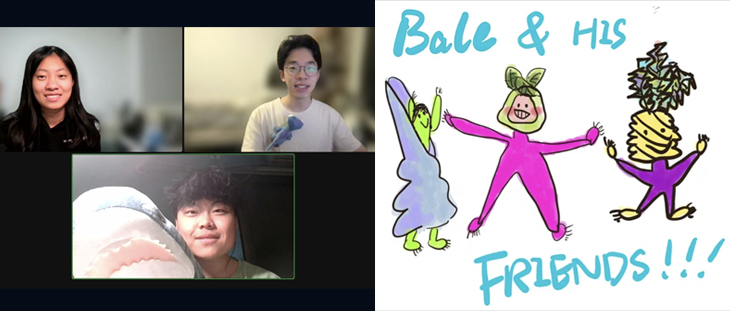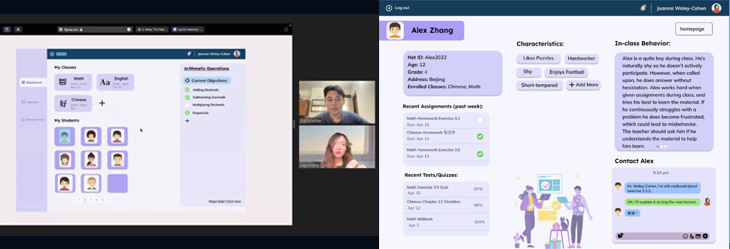NYU Shanghai Splice Club hosted its fourth hackathon, “Hack the Pearl 2022,” last weekend, bringing together some 50 students online to test their data processing and modeling abilities over three days.
A "hackathon" is a 48-hour programming, building, and designing marathon, in which teams work through the night to create a model or product with any technology. This year’s theme was “For Greater Good,” initiated by Splice Club student leaders Li Xiaoyin ’24, Alex Zou ’24 and Shen Yu ’24. It challenged students to apply what they learned in class to solve real-world health and education challenges. Though usually an in-person event, this year’s Hack the Pearl was held online due to the ongoing Shanghai lockdown to slow the spread of COVID-19.
“During this challenging time, a hackathon has very special value for our community. Its empowering spirit is all about looking outwards beyond ourselves, and reflecting on how the skills that we've learned can be applied to address real issues that others are facing,” said Vice Chancellor Jeffrey Lehman at the closing ceremony. He encouraged students to find creative uses of technology that might help people whose health and education are lagging behind those more fortunate ones.
After an intense 48-hours, Bale Chen ’24, Ivana Li ’24, and Mark Ma ’24 from Team MaVaBaNa were named Champions of the Data Modeling Track, while Siddhartha Tuladhar ’25 and Fang Jiayin ’25 from Team Relay the Pearl prevailed in the the Project-oriented Track.
Wu Peiyang ’24, Dai Linyi ’25, and Fang Yizhi ’24 from Team Keikakudoori won the “Best Innovation Award” and David Li ’24, Kevin Yao ’24, Michael Yuan ’24, and Elvin Liu ’24 from Team KNN earned the “Best Result” prize.

Left: Team MaVaBaNa Discussion via Zoom: (clockwise from top left)) Ivana Li ’24, Bale Chen ’24, and Mark Ma ’24; Right: Team comic illustration by Juliet Zhu ’25
Hackathon judges deemed Team MaVaBaNa the most successful in creating a model to predict people’s health conditions based upon a dataset of 200,000 people’s demographic, physical and mental health information. The team, consisting of two Data Science Majors and an Honors Math major, cleaned and preprocessed the raw data to make it machine-readable, set up the evaluation metrics, and implemented some basic machine learning models in the first 24 hours. During the next 24, they fine-tuned models, generated predictions of people’s health conditions, and prepared for the presentation.
They were very surprised and thrilled to win first prize. “We were not sure about the performance of our model even after the final submission. But maybe just because of our uncertainty and critical thinking, we learned how to dialectically evaluate our model from multiple perspectives to make sure it functions correctly,” said Ivana Li ’24.
The team attributed their success to Assistant Professor of Mathematics and Data Science Mathieu Laurière, who served as one of the competition judges. “Thanks to Prof. Laurière’s timely advice, we fixed a significant imbalance in the dataset and were able to overcome this incorrect step,” said Bale Chen ’24.

Left: Siddhartha Tuladhar ’25 and Fang Jiayin ’25 working on the UI design of their project; Right: A picture of the student portrait web page
In the Project-oriented Track, Team Relay the Pearl focused on education and designed the user interface (UI) of a website which could be used as a management system for online teaching. “Our project helps volunteer teachers to familiarize with each student quickly, while also helping to efficiently transfer this information to the next teacher,” said Fang. The team even brainstormed how to incorporate facial recognition and real-time feedback to help improve the quality of the education and training industry in the future.
Team Relay the Pearl approached the 48-hours as a relay race. Based in Nepal, Tuladhar was still sleeping when the hackathon kicked off. So Fang started the first page of the website on her own. When Tuladhar woke up, he continued with the second page. The seamless connection not only improved their efficiency, but also boosted their inspiration and ideas. “The virtual Hackathon made it possible for me to work remotely, so that I can realize my Hackathon dream at university,” said Tuladhar.
“Currently, there aren’t any management systems which help to create or transfer personalized information of students between teachers. Our idea fills in gaps in this market and makes us stand out,” Fang said.
“It's an achievement for Splice Club students to organize such a wonderful event during the Shanghai lockdown which shows that NYU Shanghai is still active and enduring,” said Professor of Practice in Computer Science Olivier Marin, one of the judges. “Compared with the Hack the Pearl 2019, it’s a great improvement to announce the topic one week before the Hackathon day, to let participants have more time to brainstorm. It’s an amazing experience to see students turn their ideas into concrete models and projects.”
Other judges also included Assistant Arts Professor of IMA Eric Parren, Assistant Arts Professor of IMA Gottfried Haider, two external professionals from Amazon Global Selling Tech team, Senior Manager Edward Wang and Architect Yang Yuchen.

Left: Judges Q&A session; Right: Splice Club President Li Xiaoyin ’24 having an online meeting about workshops and competition sign-up at home
“After a three-year-long hiatus caused by the COVID-19 pandemic and other reasons, we're excited to bring ‘Hack the Pearl’ back. The latest COVID lockdown took place right before we began the first large-scale promotion of our event, which brought us an enormous challenge until we confirmed that it will be moved online,” said NYU Shanghai Splice Club President Li Xiaoyin ’24. “However, the outcome was beyond our expectation. I want to thank all the NYU Shanghai community members since we cannot make it without your strong and powerful support.”


